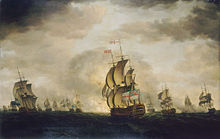John Elliot (Royal Navy officer)
His service in this conflict involved carrying the members of the Carlisle Peace Commission to America, and playing a minor role in operations off the coast, before returning to European waters.[1] The ships were caught in bad weather, and on being unable to reach the appointed rendezvous point of Groix, and with provisions running low, Elliot made instead for Kinsale to resupply, putting in there on 21 January 1760.[1] He remained trapped there by the weather, and while waiting for the opportunity to sail again a letter reached him from the Lord Lieutenant of Ireland, the Duke of Bedford, asking for assistance.The French force, consisting of the ships Maréchal de Belle-Isle, Terpsichore and Blonde, were brought to battle off the Isle of Man at 9 in the morning.[4] Among the possessions found on him was a tobacco box of chased silver and engraved with his name, which was presented to Elliot by Sir William Maxwell, who arranged Thurot's funeral and acted as chief mourner.[9] While these were being carried out it is possible that Elliot was temporarily appointed to command the 44-gun HMS Gosport, aboard which he escorted an outward bound merchant convoy headed to the Baltic.[10] With this service completed, and repairs on Aeolus being finished, Elliot resumed command of her, and spent 1761 cruising in the Bay of Biscay.[9] He spent the rest of the war in command of Chichester, going out to the Mediterranean in the later stages with Sir Charles Saunders's fleet, but they did not see any action.Edgar was part of Admiral Richard Kempenfelt's squadron of 18 ships, commanded from HMS Victory, which was ordered to intercept the convoy.[15] Elliot was moved into HMS Romney in June 1782, and there were plans to send him to the West Indies in command of a squadron of five ships of the line and a frigate, but the end of the war prevented this.[18] He fulfilled the post for its usual term, sailing out in June each year and returning in October, with his principal duties being the regulation of the fisheries.[15] He was further advanced to vice-admiral of the blue on 21 February 1790, and as tensions rose with the Spanish Armament that year, Elliot hoisted his flag aboard HMS Barfleur, but with the easing of the crisis soon struck it.[15] Increasingly infirm, he was promoted to vice-admiral of the red on 12 April 1794, after the outbreak of the French Revolutionary Wars, but was unable to take up any posts.

West FloridaJohn EliotScotlandMonteviot HouseRoxburghshireUnited KingdomRoyal NavyAdmiralHMS AeolusHMS ChichesterHMS PortlandHMS TridentHMS EdgarDowns StationSeven Years' WarAmerican Revolutionary WarBattle of Rhode IslandRelief of GibraltarBattle of Cape St VincentBattle of UshantFrench Revolutionary WarsNapoleonic WarsSir Gilbert Elliot, 2nd BtJean ElliotAmerican War of IndependenceNewfoundlandpost-captainfrigateprivateerFrançois ThurotIrelandCarlisle Peace CommissionSir George RodneyRichard KempenfeltSir Gilbert Elliott, 2nd BaronetRoyal Naval AcademyPortsmouthHMS Augustahospital shipHMS ChesterfieldHMS AssistanceHMS ScarboroughGilbert ElliotLords of the AdmiraltyChannel FleetRochefortBrittanySir Edward Hawke'sQuiberon BayHMS IntrepidKinsaleLord Lieutenant of IrelandDuke of BedfordCarrickfergusoccupied the townHMS BrilliantHMS PallasBattle of Bishops CourtMaréchal de Belle-IsleBlondeIsle of ManPort WilliamKirkmaidenWestminsterfreedom of the cityThomas PasleySpitheadKing George IIHoratio NelsonLord MintoBelle ÎleBalticBay of BiscaySir Charles Saunders'sPlymouthguardshipsMember of ParliamentCockermouthFellow of the Royal SocietycommodoreEarl of CarlisleGeorge JohnstoneWilliam EdenDelawareRichard Howe'srelief of Rhode IslandMarinesFrancis Holmanrelieve GibraltarJuan de LángaraWest IndiesErasmus GowerEnglish ChannelAdmiraltyde GuichenEast IndiesHMS VictoryUshantleewardTriomphantHMS Romneyships of the linecommander-in-chiefMark MilbankeSpanish ArmamentHMS BarfleurWilliam Cathcart, 1st Earl CathcartRobert DigbyGilbert Elliot-Murray-Kynynmound, 1st Earl of MintoHMS DefenceHMS MonarchLaughton, J. K.Nelson, HoratioParliament of Great BritainSir John MordauntCharles JenkinsonSir George MacartneyCommander-in-Chief, The DownsMatthew BuckleJohn CampbellLieutenant-Governors and Governors of NewfoundlandHaymanWhitbourneTanfieldCalvertBaltimore